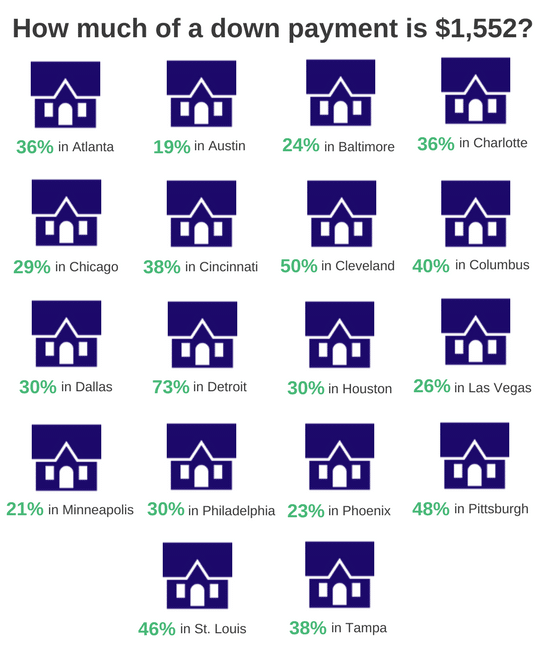This post originally appeared on the StudySoup blog.
One dilemma that nearly every college student will face is whether or not to live with a roommate. Let’s face it, there are quite a few benefits to living alone. It means more privacy, more control over personal space, and the ability to avoid the experience of a bad roommate.
But with tuition price tags continuing to skyrocket, many students are opting to forego the comforts of living alone to cut back on expenses. Though it may be less than ideal for some, the savings earned from living with a roommate throughout college may have a bigger impact on students’ financial futures than they might expect. Here’s a look at exactly just how valuable a college roommate can be.
Methodology
For this article, we first collected costs of both private and shared dorm rooms across more than 200 college campuses with the highest undergraduate enrollments. We then found average costs of both one bedroom and two bedroom off-campus apartments in those same cities.
The scenarios included in this article are built on several assumptions:
- We assume the student graduates from college in 4 years
- We assume the student spends the first two years of college living in an on-campus dorm and last two years living in an off-campus apartment
- While living in an off-campus apartment, we assume the student has signed a 12-month lease for each of the last two years of college
- We assume that in the instance the student lives with a roommate in a 2 bedroom, off-campus apartment, the lease is split 50:50, so the student is only paying half of the total rent
Further detail on methodology and calculations are provided under each scenario below.
How much does living with a roommate in college save you?
Living with a roommate can save renters up to $800 per month in some major cities. That’s just short of $10,000 in a year. But what about for college students who have the option to live on or off campus? We took a look at the average amount college students can save by living with a roommate during four years of college.
| Average Cost of an On-Campus Dorm (2 years) | Average Cost of an Off-Campus Apartment (2 years) | |
| Single | $15,816 | $29,232 |
| Shared | $11,884 | $17,640 |
| Difference | $3,932 | $11,592 |

Next, we took a look at the potential impact that savings like this could have on the financial future of college students.
What’s the value of living with a roommate in college?
We crunched the numbers and found that the money saved by having a roommate has a significant financial impact on students’ lives. Due to rising costs of attending college, more students are taking out student loans to cover the expenses of their education, including the costs of housing. The latest stats show that 43.4 million Americans currently have at least some student loans.
But regardless of how students are financing their education, $15,542 is a huge amount of savings. Even a small percentage of that could have an enormous impact on their financial futures. Here are a few examples.
In a Savings Account
With the budgets of college students being as tight as they are, it can be hard to set a little aside each month in a savings account. In fact, it turns out that saving is a habit that most Americans struggle with, as 34% have nothing at all put away. But the earlier in life you get into the habit of saving, the better off you’ll be.
Of those who are between the ages of 18 and 24 years old, 72% have less than $1,000 stashed away in savings. Meaning when they leave college, they have almost virtually nothing to help them get started to find an apartment, invest in a professional wardrobe, and more.
“The biggest habit a college student can get into is saving a portion of his or her income,” said Derek Hagen of Fireside Financial, “Saving is a powerful habit that will stick with you for life. Your savings habits are a much bigger determinant of your future wealth than the returns on your investments. There are some guidelines out there, such as saving 10 or 15% of your income, but I feel that saving anything will start the process of becoming a saver. Once you are a saver you will naturally want to save as much as you can”.
With that in mind, we took a look at what just 10% of the total average savings would mean for a college student.

In a Rainy Day Fund
No matter how much we plan, unexpected events always seem to happen. And college students are not exempt from this; cars break down, emergency flights home are needed, and companies go through rounds of layoffs.
In these instances, it’s important to have some money set aside. But as with regular savings accounts, very few college students actually have money set aside to cover these unforeseen events.
A small portion of the above average savings, such as 5%, would be enough to get a small rainy day fund set up. In this case, a student could have $778 set aside to cover their next emergency without needing to max out a credit card.

For a Down Payment on a Starter Home
As students graduate from college and move on to the next stage in their lives, many are postponing buying a home. In fact, the median age for a first time homebuyer is 31 years old. And despite knowing that owning a home is a more financially sound decision than renting, most Millennials don’t believe they can afford to take on a mortgage.
But even a small percentage of the average total savings from living with a roommate throughout college, such as 10%, could help soon-to-be graduates get a head start on saving up for a down payment on a starter home. For instance, in Pittsburgh, $1,542 is 48% of the average down payment on a starter home. It’s 50% of an average down payment on a starter home in Cleveland and 73% of an average down payment on a starter home in Detroit.

In a Retirement Investment Account
College students sometimes have a hard time understanding the need to start saving for retirement. After all, they haven’t even truly started their careers yet. Why should they start planning for the end of them?
But those with the foresight to begin investing into a retirement investment account while still in school can take greater advantage of compound interest and have a little extra set aside for their golden years.

In Student Loan Payments
While it might be nice to imagine college students setting aside their savings from living with a roommate, these scenarios are not necessarily realistic for most students. Today, graduates from public universities have an average debt of $25,550 while graduates from private, nonprofit universities have an average debt of $32,200.
Students who are using loans to finance their education should focus their attention on paying back their loans as quickly as possible and preventing interest from capitalizing. Students can minimize the amount they need in loans in the first place by agreeing to live with a roommate throughout their college education. Moreover, with an income, these savings can be used to begin paying back loans while students still attend classes.
For instance, here’s a look at how much a student who will have $39,967 in outstanding loans can have paid off by the time graduation comes around:
| Percentage of Average Total Savings Used to Pay Back Loans | Amount of Average Total Savings Used to Pay Back Loans | Amount of Outstanding Loans Remaining at Graduation |
| 5% | $776 | $39,191 |
| 10% | $1,552 | $38,415 |
| 15% | $2,329 | $37,638 |
It turns out that a college roommate can be quite valuable. College students can save enough money to have a significant impact on their financial futures, as the savings are enough to make a dent in a savings account, an emergency fund, a down payment on a starter home, a retirement investment account, and perhaps most importantly, on student loan payments.





Leave a Reply